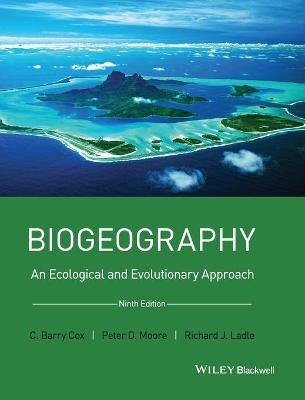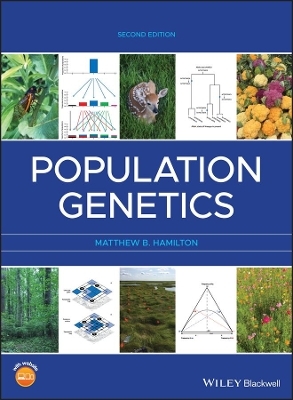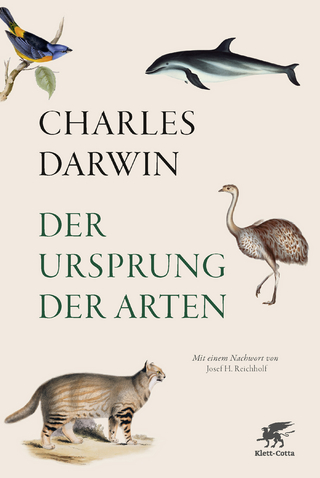
Biogeography
Wiley-Blackwell (Verlag)
978-1-118-96857-4 (ISBN)
This new edition incorporates the exciting changes of the recent years, and presents a thoughtful exploration of the research and controversies that have transformed our understanding of the biogeography of the world. It also clearly identifies the three quite different arenas of biogeographical research: continental biogeography, island biogeography and marine biogeography. It is the only current textbook with full coverage of marine biogeography.
It reveals how the patterns of life that we see today have been created by the two great Engines of the Planet - the Geological Engine, plate tectonics, which alters the conditions of life on the planet, and the Biological Engine, evolution, which responds to these changes by creating new forms and patterns of life.
Barry Cox formerly King's College, London, UK Peter D. Moore is Emeritus Reader in Ecology at King's College London. He has written extensively on ecology and global environmental change and was, for 35 years, Ecology Correspondent for the journal Nature Richard Ladle is Titular Professor of Conservation Biogeography at the Federal University of Alagoas on the northeast coast of Brazil. He is also a Senior research associate at the School of Geography in Oxford University, as well as the director of Tamandua Environmental Consultants
Preface xi Acknowledgements xiii
1 The History of Biogeography 1
Lessons from the Past 1
Ecological versus Historical Biogeography, and Plants versus Animals 3
Biogeography and Creation 4
The Distribution of Life Today 5
Evolution – a Flawed and Dangerous Idea! 7
Enter Darwin – and Wallace 8
World Maps: Biogeographical Regions of Plants and Animals 10
Getting around the World 12
The Origins of Modern Historical Biogeography 16
The Development of Ecological Biogeography 19
Living Together 20
Marine Biogeography 23
Island Biogeography 24
Biogeography Today 26
SECTION I: The Challenge of Existing 31
2 Patterns of Distribution: Finding a Home 33
Limits of Distribution 37
The Niche 38
Overcoming the Barriers 39
Climatic Limits: The Palms 41
A Successful Family: The Daisies (Asteraceae) 42
Patterns among Plovers 46
Magnolias: Evolutionary Relicts 49
The Strange Case of the Testate Amoeba 50
Climatic Relicts 52
Topographical Limits and Endemism 59
Physical Limits 60
Species Interaction: A Case of the Blues 66
Competition 69
Reducing Competition 71
Predators and Prey, Parasites and Hosts 73
Migration 76
Invasion 79
3 Communities and Ecosystems: Living Together 89
The Community 89
The Ecosystem 92
Ecosystems and Species Diversity 95
Biotic Assemblages on a Global Scale 98
Mountain Biomes 103
Global Patterns of Climate 106
Climate Diagrams 109
Modelling Biomes and Climate 112
4 Patterns of Biodiversity 117
How Many Species are There? 118
Latitudinal Gradients of Diversity 123
Is Evolution Faster in the Tropics? 131
The Legacy of Glaciation 132
Latitude and Species Ranges 133
Diversity and Altitude 134
Biodiversity Hotspots 136
Diversity in Space and Time 139
Intermediate Disturbance Hypothesis 141
Dynamic Biodiversity and Neutral Theory 142
SECTION II: THE ENGINES OF THE PLANET 147
5 Plate Tectonics 149
The Evidence for Plate Tectonics 149
Changing Patterns of Continents 154
How Plate Tectonics affects the Living World, Part I: Events on Land 154
How Plate Tectonics affects the Living World, Part II: Events in the Oceans 156
Islands and Plate Tectonics 162
Terranes 164
6 Evolution, the Source of Novelty 169
The Mechanism of Evolution: The Genetic System 172
From Populations to Species 173
Sympatry versus Allopatry 176
Defining the Species 179
A Case Study: Darwin’s Finches 180
Controversies and Evolution 183
Charting the Course of Evolution 188
SECTION III: ISLAND BIOGEOGRAPHY 193
7 Life, Death and Evolution on Islands 195
Types of Island 196
Getting There: The Challenges of Arriving 196
Dying There: Problems of Survival 197
Adapting and Evolving 199
The Hawaiian Islands 201
Integrating the Data: The Theory of Island Biogeography 208
Modifying the Theory 212
The General Dynamic Model for Oceanic Island Biogeography 214
Nestedness 216
Living Together: Incidence and Assembly Rules 216
Building an Ecosystem: The History of Rakata 218
SECTION IV: PATTERNS OF LIFE 229
8 From Evolution to Patterns of Life 231
Dispersal, Vicariance and Endemism 231
Methods of Analysis 232
Event]Based Biogeography 236
Reticulate Patterns 239
The Molecular Approach to Historical Biogeography 245
Molecules and the More Distant Past 250
9 Patterns in the Oceans 255
Zones in the Ocean and on the Seafloor 257
Basic Biogeography of the Seas 260
The Open]Sea Environment 261
The Ocean Floor 268
The Shallow]Sea Environment 273
10 Patterns in the Past 291
Early Land Life on the Moving Continents 292
One World – for a While 295
Biogeography of the Earliest Mammals 298
Early History of the Flowering Plants 303
Reconstructing Early Biomes 305
11 Setting the Scene for Today 315
The Biogeographical Regions Today 315
The Basis of Mammal Biogeography 317
Patterns of Distribution Today, I: The Mammals 319
Patterns of Distribution Today, II: The Flowering Plants 322
History of Today’s Biogeographical Regions 323
The Old World Tropics: Africa, India and South]East Asia 324
Australia 331
New Caledonia 334
New Zealand 335
The West Indies 336
South America 341
The Northern Hemisphere: Holarctic Mammals and Boreal Plants 346
12 Ice and Change 353
Climatic Wiggles 354
Interglacials and Interstadials 356
Biological Changes in the Pleistocene 358
The Last Glacial 361
Causes of Glaciation 370
The Current Interglacial: A False Start 375
Forests on the Move 377
The Dry Lands 381
Changing Sea Levels 383
A Time of Warmth 384
Climatic Cooling 386
Recorded History 388
Atmosphere and Oceans: Short]Term Climate Change 388
The Future 390
SECTION V: PEOPLE AND PROBLEMS 397
13 The Human Intrusion 399
The Emergence of Humans 399
Modern Humans and the Megafaunal Extinctions 406
Plant Domestication and Agriculture 409
Animal Domestication 414
Diversification of Homo sapiens 415
The Biogeography of Human Parasitic Diseases 417
Environmental Impact of Early Human Cultures 420
14 Conservation Biogeography 425
Welcome to the Anthropocene 425
Less, and Less Interesting 429
What is behind the Biodiversity Crisis? 430
Crisis Management: Responding to Biodiversity Loss 435
The Birth of Conservation Biogeography 437
The Scope of Conservation Biogeography 438
Conservation Biogeography in Action 443
The Future is Digital 446
Conclusions 449
Glossary 455
Index 469
Colour plates between pages 146 and 147
| Verlagsort | Hoboken |
|---|---|
| Sprache | englisch |
| Maße | 196 x 254 mm |
| Gewicht | 1252 g |
| Themenwelt | Naturwissenschaften ► Biologie ► Evolution |
| Naturwissenschaften ► Biologie ► Ökologie / Naturschutz | |
| Naturwissenschaften ► Geowissenschaften ► Geografie / Kartografie | |
| ISBN-10 | 1-118-96857-3 / 1118968573 |
| ISBN-13 | 978-1-118-96857-4 / 9781118968574 |
| Zustand | Neuware |
| Informationen gemäß Produktsicherheitsverordnung (GPSR) | |
| Haben Sie eine Frage zum Produkt? |
aus dem Bereich


